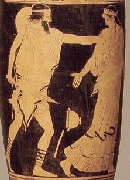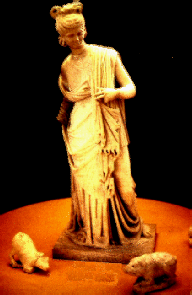Sabot, Augustin-F.: Heur et malheur d'un amour conjugal: Céphale et Procris (Ovid, Métamorphoses, VII, 661-862). in: Journées Ovidiennes de Parménie. éd. par Jean-Marc Frécaut et Danielle Porte. Bruxelles 1985 (Collection Latomus 189) 199-214.
Sabot, Augustin-F.: Le rôle des dieux dans l'historie de Ceyx (Ovide, Métamorphoses, XI, 268sqq.). in: Res sacrae. Hommages à Henri LeBonniec. Publ. par D. Porte et J.-P. Néraudeau. Bruxelles 1988 (Collection Latomus 20) 395-404.
de Saint-Denis, Eugène: Le génie d'Ovide d'après le livre XV des Metamorphoses. REL 18 (1940) 111-140.
Salvatore, Armando: La metamorfosi di Ovidio. in: Gallo, Italo; Luciano Nicastri (ed.): Cultura, poesia, ideologia nell'opera di Ovidio. Napoli 1991 (Pubblicazioni dell'università degli studi di Salerno - Sezione Atti, Convegni, Miscellanee 33) 7-26.
Carlo Santini: Le notti di Mirra , in: Ovid. Werk und Wirkung. Festgabe für Michael von Albrecht zum 65. Geburtstag. Frankfurt et al. 1999 (Studien zur klassischen Philologie) 467-476.
C. Santini: La morte di Orfeo da Fanocle a Ovidio. GIF 44 (1992) 173-181.
C. Santini: Segni grafici e Metamorfosi. in: I. Gallo, P. Esposito (Hg.): Ovidio. Da Roma all'Europa. Napoli 1998. 37-54.
Saquero, P.: El ensueno de Biblis. Ovidio y Apolonio. CFC 3 (1972) 193-200.
de Sarno, M.G.: L'armorum iudicium. Una controversia nelle Metamorfosi di Ovidio (Met 13,1-381)? AATC 51 (1986) 3-104.
Sacaffai, M.: Mirra in Ovidio, tra elegia e tragedia (Met. 10,298sgg.). Invigilata lucernis 21 (1999) 371-387.
Schade, Gerson: Ovids Aeneis. Hermes 129 (2001) 626-532.
Schawaller, Doris: Semantische Wortspiele in Ovids Metamorphosen und Heroides. GB 14 (1987) 199-214.
Wolfgang Schibel: Die Metamorphose zum Heroidenbrief. Jacob Baldes Epistola Dianae ad Venerem de morte Adonidis, in: Ovid. Werk und Wirkung. Festgabe für Michael von Albrecht zum 65. Geburtstag. Frankfurt et al. 1999 (Studien zur klassischen Philologie) 977-992.
Schickel, Joachim: Spiegelbilder. Sappho, Ovid, Wittgenstein, Canetti, Marx, Piranesi. Interpretationen. Stuttgart 1975 (Versuche 22).
Schiffer, R.: Der zweimal verwandelte Dionysos. Zur Mythenrezeption bei Ovid und Pound. Arcadia 8 (1973) 235-247.
Schindler, Wiebke und Winfried: Die Sintflut im Alten Testament und bei Ovid. AU 40,3 (1997) 36-52.
von Schirnding, Albert: Ovid, Pyramus und Thisbe (Metamorphosen IV 55-166). Ein Unterrichtsbeispiel aus Klasse 9. Anregung 15 (1969) 237-240.
Schmidt, Ernst A.: Ovids Kunst der Themenführung in den Metamorphosen. in: Musik und Dichtung. Neue Forschungsbeiträge, Viktor Pöschl zum 80. Geburtstag gewidmet. Hg. von Michael von Albrecht und Werner Schubert. Frankfurt et al. 1990 (Quellen und Studien zur Musikgeschichte von der Antike bis zur Gegenwart 23) 195-208.
Schmidt, Ernst A.: Ovids poetische Menschenwelt. Die Metamorphosen als Metapher und Symphonie. SHAW 1991,2.
Schmidt, Ernst A.: Ovid. Dichtrerische Anthropologie in Schöpfungserzählungen. in: ders.: Musen in Rom. Deutung von Welt und Geschichte in großen Texten der römischen Literatur. Tübingen 2001. 133-146.
Schmidt, Rh.: Die Übergangstechnik in Ovids Metamorphosen. Diss. Leipzig 1935.
Schmitt-von Mühlenfels, Franz: Pyramus und Thisbe. Rezeptionstypen eines Ovidischen Stoffes in Literatur, Kunst und Musik. Heidelberg 1972 (Studien zum Fortwirken der Antike 6).
Schmitz-Emans, Monika:: Metamorphoen der Metamorphosen. Italo Calvino und sein Vorfahr Ovid. Calvinos Poetik und Ovids Metamorphosen. Poetica 27 (1995) 433-469.
Schmitzer, Ulrich: Bruegel, Coecke und Ovid - ein Nachtrag. Zeitschrift für Kunstgeschichte 52 (1989) 423ff.
Schmitzer, Ulrich: Meeresstille und Wasserrohrbruch. Über Herkunft, Funktion und Nachwirkung der Gleichnisse in Ovids Erzählung von Pyramus und Thisbe (met. 4,55-166). Gymnasium 99 (100) 519-545.
Schmitzer, Ulrich: Zeitgeschichte in Ovids Metamorphosen. Mythologische Dichtung unter politischem Anspruch. Stuttgart 1990 (Beiträge zur Altertumskunde 4).
Schmitzer, Ulrich: Die lästigen Frösche. Von Aristophanes und Ovid zu Peter Handke und H.C. Artmann. Anregung 39 (1993) 372-386.
U. Schmitzer: Strenge Jungfräulichkeit. Zur Figur der Göttin Diana in Ovids Metamorphosen. WS 114 (2001) 303-321.
U. Schmitzer: Reserare oracula mentis. Abermals zur Funktion der Pythagoras-Rede in Ovids Metamorphosen, SIFC 99, 2006, 32-56.
U. Schmitzer: Exemplarische Betrachtungen zu Ovids Metamorphosen. Das Epos vom steten Wandel der Zeit, in: Humanistische Bildung 23 (2008) 69-90.
U. Schmitzer: iunctae solacia mortis und una in urna (Ov. met. 5, 73 und 11, 706). Aufgrund der Vorarbeiten von Franz Bömer ausgeführt durch Petra Fleischmann und Ulrich Schmitzer, Gymnasium 116 (2006) 529-545.
Ulrich Schmitzer: Transformierte Transformation. Eine Fallstudie zu Erzähltechnik und Rezeption der Metamorphosen Ovids anhand der Actaeon-Sage, Gymnasium 118 (2008) 23-46.
Schöner, Hans: Ovid-Interpretationen. Diss. Kiel 1956.
Schönbeck, Hans-Peter: Erfüllung und Fluch des Künstlertums: Pygmalion und Daedalus bei Ovid. Philologus 143 81999) 300-316.
Schubert, Werner: Achaemenides und Macareus (Ovids Kunst des Erzählens in Met. 14,154-440). JAC 4 (1989) 115-125.
Schubert, Werner: "Explizite und implizite Mythendeutung (Ovids Daedalus-Ikarus-Erzählung Met. 8,183-238)." Eirene 28 (1992) 25-31.
Schwabl, Hans: Zum Mythos der Zeitalter in Ovids Metamorphosen. in: Festschrift für Rudolf Hanslik. Hg. von H. Bannert und J. Divjak. Wien 1977.
Schwaiger, Bernhard: Die Darstellung des Mythos von Orpheus und Eurydike bei Vergil georg. 4,453-527, Ovid met. 10,1-77 und Boethius cons. phil. 3 m 12 im Vergleich. Dipl.Arbeit Innsbruck 1995.
Sdunnus, U.: The story of Dryope. A rare subject from Ovid’s "Metamorphoses", Journal of the Warburg and Courtauld Institutes, 53 (1990) 312-315.
Secci, Davide A.: Ovid Met. 9.1-97: through the Eyes of Achelous, Greece & Rome 56 (2009) 34-54.
Segal, Charles P.: Circean Temptations: Homer, Vergil, Ovid. TAPhA 99 (1968) 419-442.
Segal, Charles: Landscape in Ovid's Metamorphoses. A Study in the Transformations of a Literary Symbol. Wiesbaden 1969 (Hermes Einzelschriften 23).
Segal, Charles: Liebestod, Monument and Metamorphosis in Ovid, Beroul, Shakespeare, and some others. in: Hommage à Jean Granarolo. Philologie, Littératures et Histoire Anciennes. Textes réunis par René Braun. Paris 1985 (AFL Nice 50).
Segal, Charles: Myth and Philosophy in the Metamorphoses. Ovid's Augustanism and the Augustan Conclusion of Book XV. AJPh 90 (1969) 257-292.
Segal, Charles: Ovid's Cephalus and Procris. Myth and Tragedy. GB 7 (1978) 175-205.
Segal, Charles: Ovid's Orpheus and Augustan Ideology. TAPhA 103 (1972) 473-494.
Segal, Charles: Ovid's Metamorphoses. Greek Myth in Augustan Rome. SPh 68 (1971) 371-394.
Segal, Charles: Ovidio e la poesia del mito. Saggi sulle Metamorfosi. Venezia 1991.
Segal, Charles: Philomela's Web and the Pleasure of the Text. Ovid's Myth of Tereus in the Metamorphoses. in: Robert M. Wilhelm, Howard James (edd.): The Two Worlds of the Poet. New Perspectives on Vergil. Detroit. 1992. 281-295.
Segal, Charles: Senecan Baroque. The Death of Hippolytus in Seneca, Ovid and Euripides. TAPhA 114 (1984) 311-325.
Segal, Charles: The Magic of Orpheus and the Ambiguity of Language. Ramus 7 (1978).
Charles Segal: Ovid's Arcadia and the characterization of Jupiter in the Metamorphoses, in: Ovid. Werk und Wirkung. Festgabe für Michael von Albrecht zum 65. Geburtstag. Frankfurt et al. 1999 (Studien zur klassischen Philologie) 401-412.
Segal, Charles: Intertextuality and Immortality: Ovid, Pythagoras and Lucretius in Metamorphoses 15. MD 46 (2001) 63-102.
Segl, Rudolf: Die Pythagorasrede im 15. Buch von Ovids Metamorphosen. Diss. Salzburg 1970.
Semlitsch, Anne-Christine: Ovid-Zyklen in der steirischen Deckenmalerei des 17. Jahrhunderts. Dipl.Arbeit Graz 1995.
Aldo Setaioli: L'impostazione letteraria del discorso di Pitagora nel XV libro delle Metamorfosi, in: Ovid. Werk und Wirkung. Festgabe für Michael von Albrecht zum 65. Geburtstag. Frankfurt et al. 1999 (Studien zur klassischen Philologie) 487-514.
Sharrock, A.R.: Womanufacture. JRS 81 (1991) 36-49. [scil. Pygmalion]
Sharrock, A.R.: An a-musing tale: gender, genre, and Ovid's battles with inspiration in the Metamorphoses, in: Cultivating the Muse. Struggles for power and inspiration in classical literature. Efrossini Spentzou and Don Fowler (Edd.). Oxford 2002. 207-227.
Scheglov, Yu. K.: Some Features of the Structure of Ovid's "Metamorphoses". in: Russian Poetics in Translation 2. Oxford 1976. 50-65.
Sibelis, Johannes: Wörterbuch zu Ovids Metamorphosen. 5. Auflage besorgt von Friedrich Polle. Leipzig 1893.
Siciliano, Raimondo Lucano e ovidio. Piccolo contributo allo studio dei rapporto. Maia 50 (1997) 309-316.
J. Siegel: Child-feast and revenge. Ovid and the myth of Procne, Philomela and Tereus. Diss. Rutgers Univ. 1994.
Simonetti, Giuseppina: Tecnica descrittiva delle Metamorfosi ovidiane. L'episodio di Dafne e quello di Driope. RCCM 17 (1975) 95-106.
Simons, Benedikt: Die Metamorphose des Narcissus bei Ovid und Benjamin Britten, AU 52/2 (2009) 52-59.
Michael Simpson: The Metamorphoses of Ovid, Amherst 2001.
Slater, D.A.: Towards a Text of the Metamorphosis of Ovid. Oxford 1927.
Smith, R. Alden: Ov. Met. 10.475. An Instance of "Meta-allusion". Gymnasium 97 (1990) 458ff.
Smith, R. Alden: Allusion of grandeur. Studies in the intertextuality of the "Metamorphoses" and the "Aeneid". Diss. Univ. of Pennsylvania 1990.
Smith, R. Alden: Epic Recall and the Finale of Ovid's Metamorphoses. MH 51 (1994) 45-53.
Smith, R. Alden: Poetic Allusion and Poetic Embrace in Ovid and Virgil, Ann Arbor 1997.
Sniezèwski, St.: De eis quae Ovidius in metamorphoseon libris de Augusto eiusque gestis senserit. Menander 43 (1988) 397-409.
Solodow, Joseph B.: The World of Ovid's Metamorphoses. Chapel Hill, London 1988.
Soubiran, Jean: Autour de Numa (Ovide, Metamorphoses, XV). VL Nr. 113 (1989) 11-17.
Spahlinger, Lothar: Ars latet arte sua. Die Poetologie der Metamorphosen Ovids. Stuttgart, Leipzig 1996 (Beiträge zur Altertumskunde).
Spencer, Richard Albert: Contrast in Ovid's Metamorphoses. Thesis (Ph.D.) - The University of North Carolina at Chapel Hill, 1996.
Gabriele Stein: Mutter - Tochter - Geliebte. Weibliche Rollenkonflikte bei Ovid, München, Leipzig 2004 (Beiträge zur Altertumskunde 204).
Steinberg, M.E.: El mito de Medea en Ovidio, Met. VII 1-424, Anals de Filologia Clasica 16-17 (1998-99) 211-226.
Steiner, Grundy: Ovid's carmen perpetuum. TAPhA 89 (1958).
Steiner, Grundy: Source-Editions of Ovid's Metamorphoses (1471-1500). TAPhA 82 (1951) 219-231.
Steiner, Grundy: The Textual Tradition of the Ovidian Incunabula. TAPhA 83 (1952) 312-318.
Steinkühler, Martina: Macht und Ohnmacht der Götter im Spiegel ihrer Reden. Ammesbek bei Hamburg 1989 (Wissenschaftliche Beiträge aus europäischen Hochschulen, Reihe 05, Bd. 3).
Stephens, Wade C.: Two Stoic Heroes in the Metamorphoses. Hercules and Ulysses. in: Ovidiana. Recherches sur Ovide. Publiées à l'occasion du bimillénaire de la naissance du poète par Nicolas I. Herescu. Paris 1958.
Stirrup, Barbara E.: Ovid. Poet of Imagined Reality. Latomus 40 (1981) 88-104.
Stirrup, Barbara E.: Ovid's Narrative Technique. A Study of Duality. Latomus 35 (1976) 97-107.
Stirrup, Barbara E.: Techniques of Rape. Variety of Wit in Ovid's Metamorphoses. G&R 24 (1977) 170-184.
Stitz, Margarete: Ovid und Vergils Aeneis. Interpretation Met. 13,623-14,608. Diss. Freiburg i. Br. 1962.
Stoessl, Franz: Der Tod des Herakles. Arbeitsweise und Formen der antiken Sagendichtung. Zürich 1945.
Victor I Stoichita: The Pygmalion Effect: From Ovid to Hitchcock, Chicago 2008.
Stolzenhain, Tilo: Metamorphosen - Bilder zu Ovid. Gedanken über Kunstwerke zu literarischen Vorlagen. in: Antikerezeption heute. Protokoll eines Kolloquiums. Stendal 1985 (Beiträge der Winckelmann-Gesellschaft 13) 115-119.
Suerbaum, Werner: Die objektiv und die subjektiv erzählende Göttin. Der Bericht von der Jugend Camillas (Verg. Aen. 11,535-586) und die Erzählung der Venus von Hippomenes und Atalanta (Ovid met. 10,560-707). WJA NF 6A 1982.
Swanson, Roy Arthus: Ovid's Pythagorean Essay. CJ 54 (1958).


